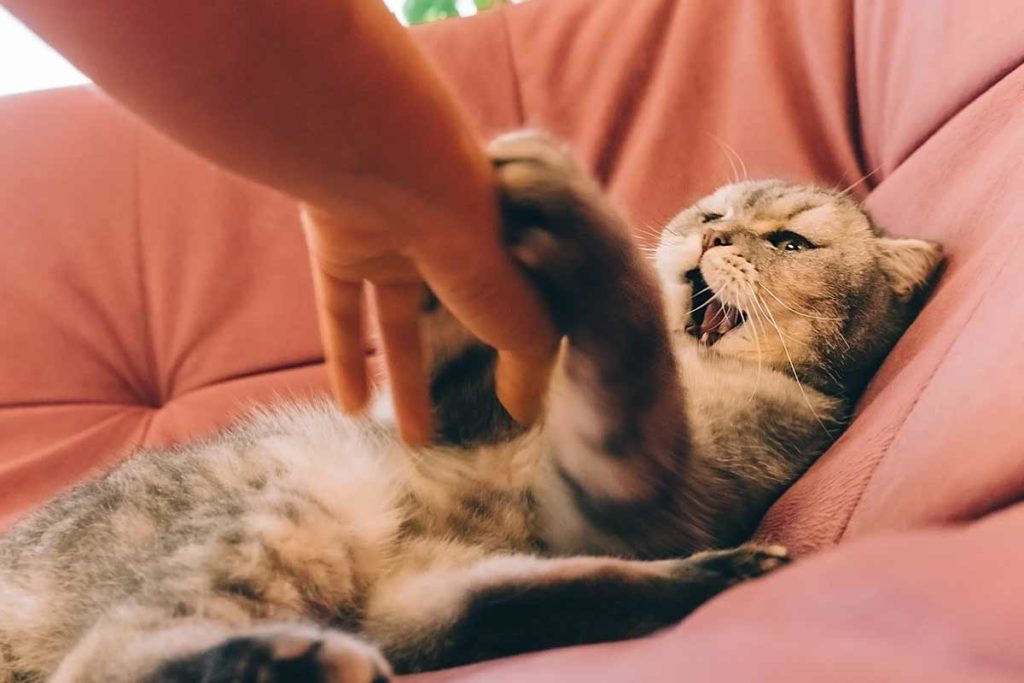Have you ever been peacefully petting a purring cat, only to have them turn around and swat their claws at you or try to bite your hand? Sudden cat aggression, considered hostile or violent behavior intended to dominate or intimidate, is a fairly common behavioral problem in cats. In fact, aggression is the second most common feline behavior problem seen by animal behaviorists, behind issues with the litter box.
Why do cats suddenly exhibit aggression? What can you do to address your cat’s aggressive behavior?
Table of contents
- Consequences of cat aggression
- Signs of aggression in cats
- Reasons for sudden cat aggression
- How can ElleVet’s CBD + CBDA help stressed cats?
- How to calm an aggressive cat
- What not to do with an aggressive cat
- Conclusion
Consequences of cat aggression
Cats are born with five potential weapons: their mouth full of sharp teeth and four clawed paws. Aggression in cats can range from hissing to a full-on attack, which can result in painful injuries to you or other pets and even lead to rehoming your cat. According to the Cornell Feline Health Center, a recent study reported that 27 percent of cats relinquished to shelters for behavioral reasons were surrendered for aggression.
Cats can bite and inflict severe injuries, which are painful and can easily become infected. They can also cause cat scratch fever, a usually benign but potentially serious infectious disease that causes flu-like symptoms. Fights between cats rarely result in fatalities, but they can lead to infections and result in considerable veterinary expenses for cat parents. Aggressive cats can be risky to have at home and can pose a real danger to family and visitors.
Signs of aggression in cats
Feline aggression can occur unexpectedly for a multitude of reasons. It can be difficult to identify signs that a cat may be about to exhibit aggressive behavior. However, aggression in cats rarely comes about entirely suddenly, as there are some subtle warning signs cat parents can keep an eye out for.
Watch out for changes in a cat’s body language, including:
- Dilated pupils
- Fast tail twitching or thrashing
- Direct stare
- Crouched or arched posture
- Ears flattened or oriented backward
- Raised hair along spine
- Stiff posture
- Vocalization such as hissing, growling, or yowling
- Swatting
- Biting
Reasons for sudden cat aggression
Several different factors can trigger or cause aggression in cats. Being able to identify the reasoning behind your cat’s behavior can help you address any issue or prevent aggression in the future. Some possible reasons for aggression in cats can include:
Fear and stress
If your cat feels threatened, unsafe, overstimulated, or stressed, they may become aggressive as a means of protecting themselves. Changes in the household or environment such as new people, loud noises, other pets, or even different smells can create stress for a cat. While cats can be fearful of new things, they may also exhibit fear or stress if they have developed a negative association based on a previous experience.
Discomfort
Cats that are experiencing discomfort may act aggressively toward people or other pets in an attempt to avoid touch, movement, or certain activities that might worsen the discomfort. Cats are naturally stoic animals and do not show discomfort and vulnerability outwardly, so more subtle behaviors like hiding, decreased appetite, lethargy, or aggression can indicate your cat is uncomfortable. This discomfort may be caused by injury, illness like dental disease, or joint discomfort.
Play
Learning appropriate play is an important part of a cat’s socialization, and this normally occurs during time spent with littermates. Cats learn that they are biting or scratching too hard when their littermates stop playing or retaliate. Cats raised alone during their early lives may not learn this important lesson, so their play style can be interpreted as aggressive.
Territorial behavior
Cats are creatures of habit and routine. Some cats may become protective of their territory if changes occur in their environment or if they feel threatened in their “safe space.” This can happen with visitors or new people or animals in the house or neighborhood. This aggression commonly takes the form of swatting, chasing, and attacking the intruder.
Inter-cat aggression
Similar to territorial behavior, cats may occasionally show signs of aggression toward people or other pets when they want to establish social dominance. This is most common between male cats as they approach social maturity between two and four years of age, and sexual hormones play an important role in these interactions.
Redirection
When a cat is startled or upset by a stimulus but cannot respond directly, they may redirect their reaction toward a human or another cat. In this case, it may not have been anything you did at all—perhaps there is a squirrel in the front yard, or another dog walking by with their owner. Redirected aggression can be the most challenging and dangerous behavior to prevent since it can be seemingly unprovoked.
Petting
For reasons still poorly understood, some cats may become suddenly aggressive while being pet. It’s possible that the repetitive motion over time turns from pleasant to irritating. Other potential explanations include overstimulation and an attempt by the cat to control when the petting ends. Handling, bathing, grooming, and nail trimming can also cause this type of aggression.
How can ElleVet’s CBD + CBDA help stressed cats?
Unfortunately, both stress and joint discomfort can take a serious toll on cats’ health and quality of life. When these issues lead to sudden cat aggression, it can be very challenging and potentially dangerous for you, too.
ElleVet’s CBD + CBDA feline oil and paste can help cats’ stress levels decrease and return to a normal state of balance. By truly calming without sedating, CBD + CBDA allows cats to relax in stressful situations and learn that their triggers are not something to be afraid of, helping to reduce their stress response over time.
CBD + CBDA is also extremely effective in offering cats support for joint discomfort that can occur from injury, illness, abnormality, or daily wear and tear. By working to improve discomfort and reduce inflammation, ElleVet’s CBD + CBDA can provide much needed relief for cats who have stopped doing their normal activities and do not accept being touched due to joint discomfort. In helping your cat be more comfortable, ElleVet’s CBD + CBDA can lead to improved overall well-being!
As always, consult your veterinarian if your cat shows signs of stress or discomfort. For any questions about ElleVet’s CBD + CBDA products or how CBD can help your feline friend live their best life, give us a call (844-673-7287) or send us an email ([email protected]). We are here to help.
How to calm an aggressive cat
When it comes to addressing your cat’s aggressive behavior, particularly when the behavior comes on suddenly, early intervention is best. You will also need to be able to identify the triggers causing your cat’s aggression in order to properly address these issues. Consider consulting your veterinarian, as they will be able to rule out any health issues that may be causing your feline friend physical discomfort.
Here are some more tips for safely and effectively addressing your cat’s aggressive behavior:
- Consult your veterinarian to rule out or address any possible health issues that may be causing your cat discomfort or stress.
- Separate cats that act aggressively toward each other and have cats neutered and spayed to reduce hormone-related aggressive behavior.
- Give your cat space to let them calm down in a private, quiet, and secure place without injuring anyone or causing any destruction.
- Redirect their attention with a toy. Any objects used to distract a cat should be kept at a distance from your hands so they cannot bite or scratch you.
- Play with your cat and provide them with ample mental and physical stimulation. Sometimes, bored cats can become overstimulated as they attempt to entertain themselves. Keeping them entertained, such as through play, can prevent sudden aggression, reduce stress, and enhance your bond.
- Remove triggering stimuli. For example, close the window blinds to prevent your cat from seeing outside, or prohibit them from going under the bed.
- Gradually desensitize your cat to triggering events, objects, or experiences and use positive reinforcement if they cannot be avoided entirely. Briefly expose your cat to the stimulus from a distance, and then reward non-aggressive behavior with food and praise. This includes slow, gradual introductions or reintroductions with other cats.
- Call a pet behaviorist. A behaviorist who specializes in cats can help you identify what’s triggering your cat’s aggression and give you tips to help your feline friend cope.
What not to do with an aggressive cat
Just as important as understanding what to do when your cat suddenly becomes aggressive is knowing what not to do. Aggression in cats can easily worsen if inadvertently encouraged or not addressed properly. Here are some things to avoid when your cat gets aggressive:
- Avoid unnecessary handling, touching, and grooming if your cat exhibits aggressive behavior due to discomfort or petting. This is particularly challenging with children, who may want to handle the cat but miss important cues about how the cat will react.
- Do not react to your cat’s aggressive behavior. Punishment can increase a cat’s fear and stress, while consoling them may communicate approval of their behavior. It is also important not to retreat or show fear, as this may reinforce the behavior if your retreat is what the cat wants. Ignoring your cat when they exhibit aggression is best.
- Don’t rush introductions or reintroductions between cats and other pets or humans. Your cat is more likely to respond positively to new acquaintances if the process is gradual and comfortable for them.
- Never get between cats that are fighting, as you can be seriously injured.
Conclusion
Cat aggression often isn’t random or sudden, even if it feels that way to us. Cats typically display cues they’re upset about something before they bite or swat, so it is important for owners and those who spend time around felines to be able to identify warning signs. Determining the cause of your cat’s aggressive behavior is essential for addressing their discomfort or stress and making life more pleasant for all of you.









